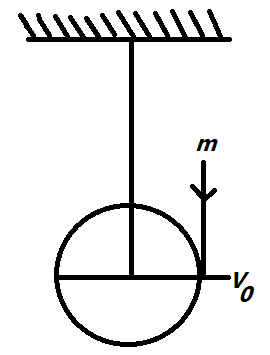
A uniform disc of mass M and radius R is hanging from a rigid support and is free to rotate about a horizontal axis passing through its centre in the vertical plane as shown. An insect of mass m falls vertically and hits the disc at a point at horizontal diameter with a velocity ${v_0}$ and sticks on it. Calculate the minimum value of ${v_0}$ so that the disk completes the vertical circular motion.

Answer
220.5k+ views
Hint: Here in this question, we have to find the minimum value of the velocity by which the disk completes the vertical circular motion. To find this, we must know about conserving angular momentum. A spinning system's ability to conserve angular momentum ensures that its spin will not change until it is subjected to an external torque and in other words the rotation's speed will not change as long as the net torque is zero.
Formula used:
According to conservation of angular momentum,
$m{v_0}R = \left( {\dfrac{{M{R^2}}}{2} + m{R^2}} \right)\omega $
Here, $m$ is the mass of the insect, $v_0$ is insect velocity, $M$ is the mass of the disc and $R$ is its radius and $\omega$ is the angular velocity.
Complete step by step solution:
We know that preserving the system's overall angular momentum around the disc's centre of mass,
$m{v_0}R = \left( {\dfrac{{M{R^2}}}{2} + m{R^2}} \right)\omega $
Here we need the value of omega, so taking omega one side and getting the value of it,
$\omega = \dfrac{{2m{v_0}}}{{(M + 2m)R}} .....(i) \\ $
After which taking conservation of energy we get,
$mgR = \dfrac{1}{2}\left( {\dfrac{{M{R^2}}}{2} + m{R^2}} \right){\omega ^2}.....(ii) \\ $
By putting the value of $\omega $ from equation(i) to equation(ii) we get the final value as,
$mgR = \dfrac{1}{2}\left( {\dfrac{{M{R^2}}}{2} + m{R^2}} \right)\left( {\dfrac{{2m{v_0}}}{{(M + 2m)R}}} \right) \\ $
Here in the above equation, we need the value of velocity ${v_0}$ , so by finding velocity we get the value as,
${v_0} = \sqrt {\dfrac{{\left( {M + 2m} \right)gR}}{m}} $
Here in the above equation, we get the final value of velocity.
Therefore, the minimum value of the velocity by which the disk completes the vertical circular motion is ${v_0} = \sqrt {\dfrac{{\left( {M + 2m} \right)gR}}{m}}$.
Note: When a body moves in a vertical circle so that its motion at various points varies, the movement is referred to as vertical circular motion. Consider a massed object that is tethered to one end of an infinitely long, extendable string and rotated in a vertical arc of radius r.
Formula used:
According to conservation of angular momentum,
$m{v_0}R = \left( {\dfrac{{M{R^2}}}{2} + m{R^2}} \right)\omega $
Here, $m$ is the mass of the insect, $v_0$ is insect velocity, $M$ is the mass of the disc and $R$ is its radius and $\omega$ is the angular velocity.
Complete step by step solution:
We know that preserving the system's overall angular momentum around the disc's centre of mass,
$m{v_0}R = \left( {\dfrac{{M{R^2}}}{2} + m{R^2}} \right)\omega $
Here we need the value of omega, so taking omega one side and getting the value of it,
$\omega = \dfrac{{2m{v_0}}}{{(M + 2m)R}} .....(i) \\ $
After which taking conservation of energy we get,
$mgR = \dfrac{1}{2}\left( {\dfrac{{M{R^2}}}{2} + m{R^2}} \right){\omega ^2}.....(ii) \\ $
By putting the value of $\omega $ from equation(i) to equation(ii) we get the final value as,
$mgR = \dfrac{1}{2}\left( {\dfrac{{M{R^2}}}{2} + m{R^2}} \right)\left( {\dfrac{{2m{v_0}}}{{(M + 2m)R}}} \right) \\ $
Here in the above equation, we need the value of velocity ${v_0}$ , so by finding velocity we get the value as,
${v_0} = \sqrt {\dfrac{{\left( {M + 2m} \right)gR}}{m}} $
Here in the above equation, we get the final value of velocity.
Therefore, the minimum value of the velocity by which the disk completes the vertical circular motion is ${v_0} = \sqrt {\dfrac{{\left( {M + 2m} \right)gR}}{m}}$.
Note: When a body moves in a vertical circle so that its motion at various points varies, the movement is referred to as vertical circular motion. Consider a massed object that is tethered to one end of an infinitely long, extendable string and rotated in a vertical arc of radius r.
Recently Updated Pages
Mass vs Weight: Key Differences Explained for Students

Electricity and Magnetism Explained: Key Concepts & Applications

JEE Energetics Important Concepts and Tips for Exam Preparation

JEE Isolation, Preparation and Properties of Non-metals Important Concepts and Tips for Exam Preparation

JEE Main 2021 July 25 Shift 1 Question Paper with Answer Key

JEE Main 2021 July 22 Shift 2 Question Paper with Answer Key

Trending doubts
JEE Main 2026: Application Form Open, Exam Dates, Syllabus, Eligibility & Question Papers

Understanding Uniform Acceleration in Physics

Derivation of Equation of Trajectory Explained for Students

Hybridisation in Chemistry – Concept, Types & Applications

Understanding the Angle of Deviation in a Prism

How to Convert a Galvanometer into an Ammeter or Voltmeter

Other Pages
Thermodynamics Class 11 Physics Chapter 11 CBSE Notes - 2025-26

JEE Advanced Marks vs Ranks 2025: Understanding Category-wise Qualifying Marks and Previous Year Cut-offs

Units And Measurements Class 11 Physics Chapter 1 CBSE Notes - 2025-26

NCERT Solutions For Class 11 Physics Chapter 8 Mechanical Properties Of Solids

Motion in a Straight Line Class 11 Physics Chapter 2 CBSE Notes - 2025-26

Laws of Motion Class 11 Physics Chapter 4 CBSE Notes - 2025-26




